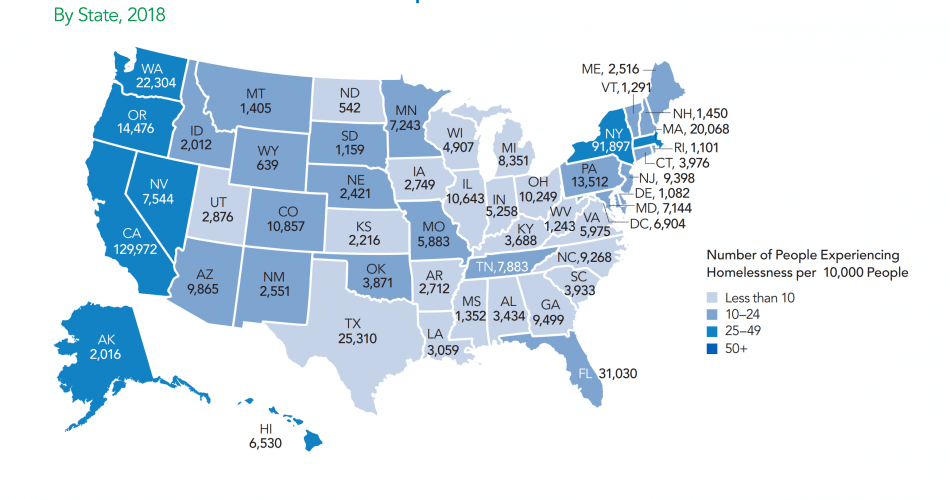Reading time: 5 minutes
On any given day in the United States, there are more than 550,000 people experiencing homelessness. This number captures both unsheltered (those living on the street) and sheltered (those living in emergency shelters, transitional homes, and in cars or on couches) individuals. Recently, homelessness has garnered significant national media attention, with headlines such as San Francisco’s $100 million proposed budget to tackle homelessness, increasing awareness of the crisis.
Homelessness is a problem across the country, not just in the coastal urban centers that get the most attention. Homeless is a complex issue with myriad causes. Families and individuals enter homelessness in a variety of ways, and homelessness, whether temporary or chronic, is far more widespread than most imagine. Successful policy interventions must unpack the complicated causes of homelessness to be develop solutions.
Homelessness is the product of a broken housing ecosystem. In a healthy housing market, the number of housing units available will match the number of households seeking a home, allowing most families and individuals to access stable, affordable housing. However, our housing ecosystem is not functioning as it should. From 2000 – 2015, the U.S. underproduced housing by 7.3-million units. This underproduction leaves millions of Americans without access to this most critical resource. Without enough housing units, many families get left behind, forced into long periods without a permanent and stable place to live.
Beyond the undersupply of housing, homelessness is also fueled by a lack of funding for low-income families and lack of wraparound services for the most vulnerable populations. Widespread, long-term homelessness has major consequences for economic mobility, public health, and safety. Understanding the complexity of the issue is critical for creating the right solutions.
Perhaps the most commonly considered portrait of homelessness is that of chronically homeless individuals – those living unsheltered for long periods of time who often suffer from mental illness, military service-related PTSD, substance abuse, or developmental disabilities. According to HUD, chronically homeless people make up about a quarter of the total homeless population. For this population, successful policy interventions include important measures like permanent supportive housing and rapid rehousing programs that offer wraparound services along with safe housing. For the majority of families and individuals experiencing homelessness, however, a lack of affordable housing is one of the strongest causes of homelessness.
Severe housing underproduction pushes rents to unsustainably high levels that take huge tolls on household budgets. In fact, approximately 50% of renter households are cost-burdened, paying more than 30% of their income on rents. This cost burdening is felt even more deeply by low-income families, who often pay more than 50% of their income on housing costs. This level of cost-burdening is unsustainable and the continued underproduction of homes will push more and more people into homelessness. These families are often one unexpected expense from not being able to make their monthly rent or mortgage payment. Overcoming barriers to creating more housing at both affordable and market rate levels is a critical step in reducing homelessness nationwide. Without access to housing, more families and individuals will run out of options and be forced into homelessness.
What are some of the solutions that will combat homelessness? Beyond building more homes for people of all income levels, comprehensive policies that provide more housing units for low-income Americans are critical for addressing this crisis. Programs like the Low-Income Housing Tax Credit (LIHTC), which is one of the primary ways that low income housing gets built in America, can deliver much-needed financial support to lower-income families and individuals. The Affordable Housing Credit Improvement Act seeks to increase the allocation and lending authority for LIHTC so that it can meet increased demand for affordable housing.
For far too long, homelessness has been in the shadows of public policy debates. But the severity of the homelessness crisis is forcing it into the light. Public policy debates over housing must specifically address how we ensure all Americans are able to access and stay in an affordable home.
